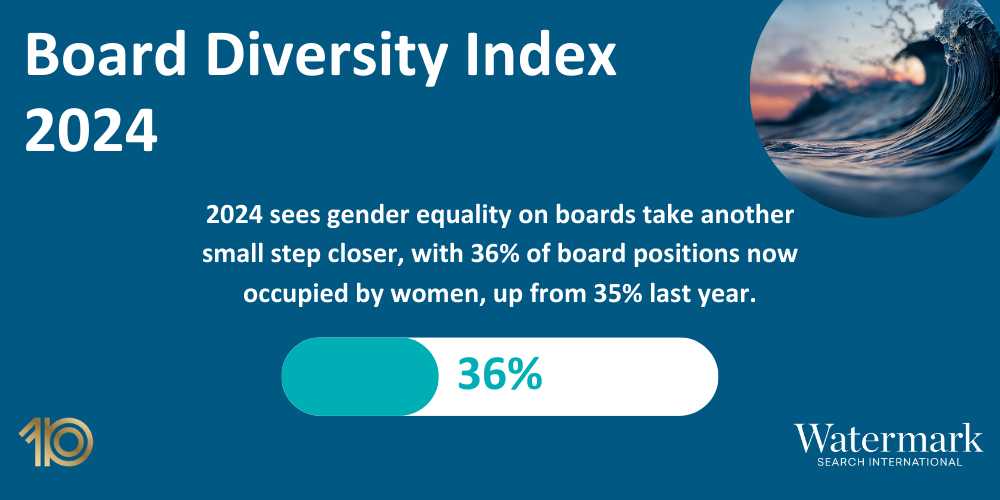Gender representation on ASX300 boards hasn’t changed much over the last few years – and we’re still a fair way from equality. As long as boards continue to be mostly “stale, male and pale”, companies are missing out on the business advantages of the diversity of thought which comes with a more representative board.
Is the news all bad for gender diversity on boards?
Thankfully, no. While progress remains at a glacial pace, the fact is more women have gained board positions during the decade, moving towards gender equality on ASX300 boards.
By 2020, ASX300 boards had reached their target of 30% women directors overall, which signalled progress towards a gender ratio of 40:40:20 across all boards by 2030.
As Watermark’s 2024 Board Diversity Index shows, gender equality on boards has taken another small step closer, with 36% of board positions now occupied by women.
Although this small step translates to only a sixth (16%) of boards having at least 50% women directors, we can celebrate some progress. In 2023 year more than 69% of ASX300 boards now have 30% or more women; boards with one women has jumped to 45 (from 34 in 2023) and the number of all male boards has dropped to 13, from 15 last year. So the math tells us that women held 300 ASX300 board seats in 2016 and a grand total of 755 at this point in 2024. And to cheer things along a little further, boards with at least 30% women nearly quadrupled.
Board diversity shouldn’t be about tokenism
In 2024, supposedly more enlightened times, does the gender imbalance on company boards remain due to patriarchal attitudes and gender-biased appointments? Can there be other aspects at play?
We know female board members are often – rightly – selective in which boards they join. This is because they want their voices heard and valued, which is a fundamental expectation. Well-versed women do not want to be considered for a role merely to tick a box.
Having 30% gender diversity is recognised as the tipping mechanism that enables the dynamics of the board conversation to change. As such, female board members are often more likely to join boards with more than one female at the table. This can almost be viewed as a “chicken or the egg” scenario, but this is where an open approach to diversity can change the play.
There’s nothing stopping a board from approaching and appointing a candidate who may not have stepped forward, making it clear it is not a box-ticking exercise and it’s their skills and outlook viewed as positive essentials for the board’s success.
Watermark Search International has extensive experience here: our board appointments services help companies look outside the box to broaden the diversity of their board, build new skills into the board and conduct successful onboarding for new directors.
Women leaders have proven they add value – why aren’t more companies listening?
Women sitting on boards are one thing, but what about women sitting in the chair? Back in 2020, the ABC reported research showing: “Companies who appointed a female CEO increased their market value by 5% – worth nearly $80 million to an average ASX200 company.” The report also noted – with key importance – that a 10% or more increase the number of women in other key leadership positions also increased a company’s market value by 6.6%. What’s that worth dollars and cents? An average $105 million!
This year, the Australian Securities Exchange revealed only 26 of ASX300 companies have a woman at the top, that’s up from 18 in 2022. However, on a broader scale, of the 42 CEO appointments made during the past year, only 10 were female.
What needs to be done to improve gender diversity on boards?
Aspirational targets measures are one thing, but solidly implemented rules are another. In the UK, The Financial Conduct Authority (FCA) Listing Rules require companies to report on whether at least 40% of the board are women and at least one of the senior board members is a women (chair, CEO, CFO or a senior independent director).
In the European Union, the Financial Conduct Authority (FCA) Listing Rules require companies to report on whether at least 40% of the board are women; at least one of the senior board members is a women (chair, CEO, CFO or a senior independent director); and at least one member of the board is from an ethnic minority background, excluding white British or other white groups.
While progress may be slow in Australia, there is a compelling momentum towards greater female representation – if not equality. There are now significantly fewer boards with zero or one women directors and substantially more boards with at least 30% women directors.
Appointing and encouraging diverse talent shouldn’t be seen as a risky path to creating a smoothly functioning and board with a progressive outlook. In the ten years we’ve been publishing the Board Diversity Index we’ve seen more companies make a healthy move away from groupthink to champion genuine diversity thought. But the old ways of thinking about board makeup are still prevalent.
When we published our 2024 Board Diversity Index in April, Governance Institute chair Pauline Vamos explained in an interview with the Western Australian: “The recruitment of directors has become trapped in a cycle of repetition and reliance on the same outdated processes and skills matrices no longer suited to contemporary demands. It is imperative that we break free from this inertia. Boards need to become better at envisioning what the organisation might look like in five, 10 years' time and start planning now for the type of board 'personality' required to get there.”
